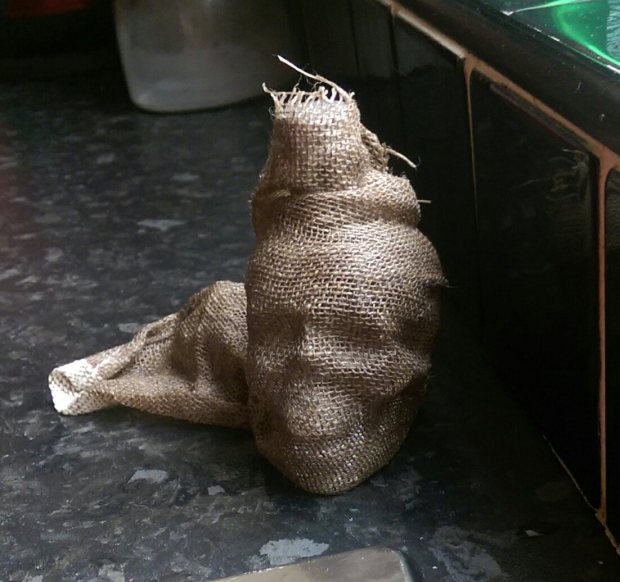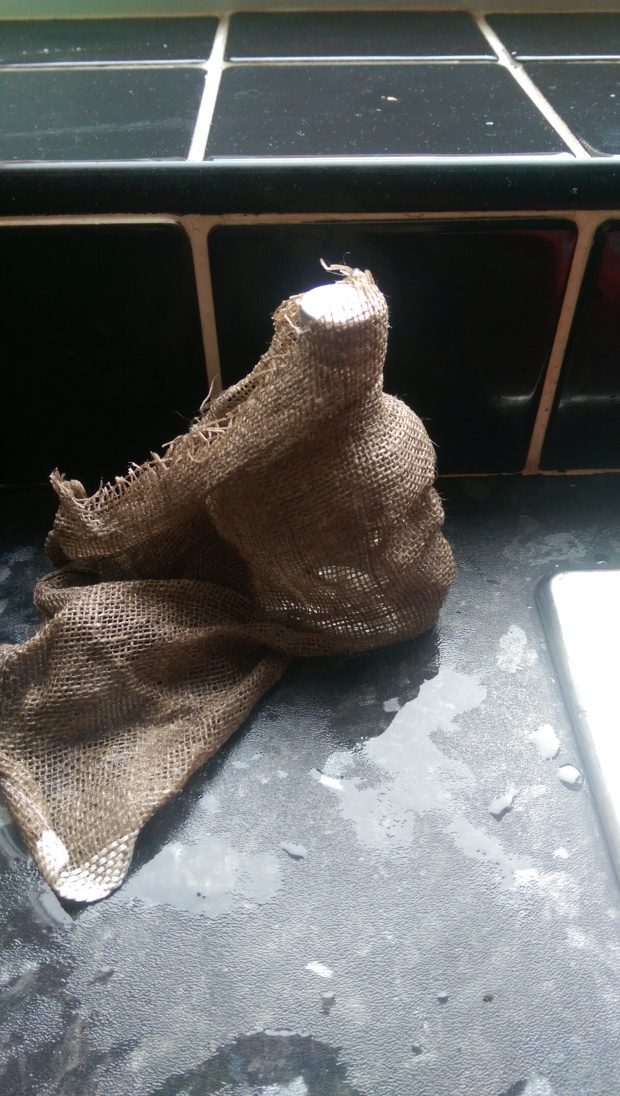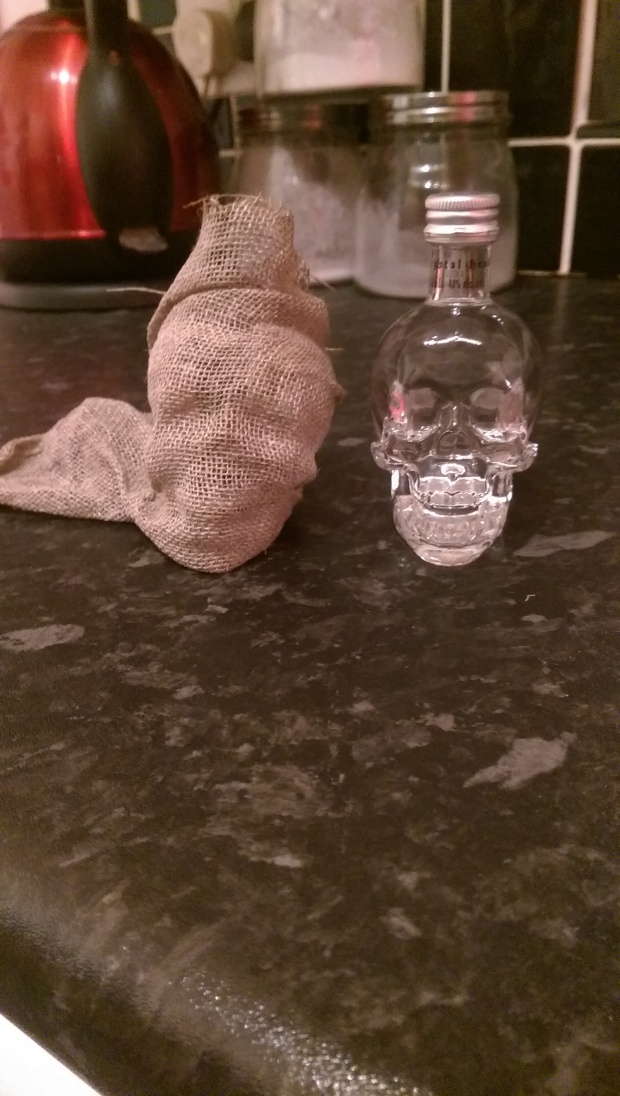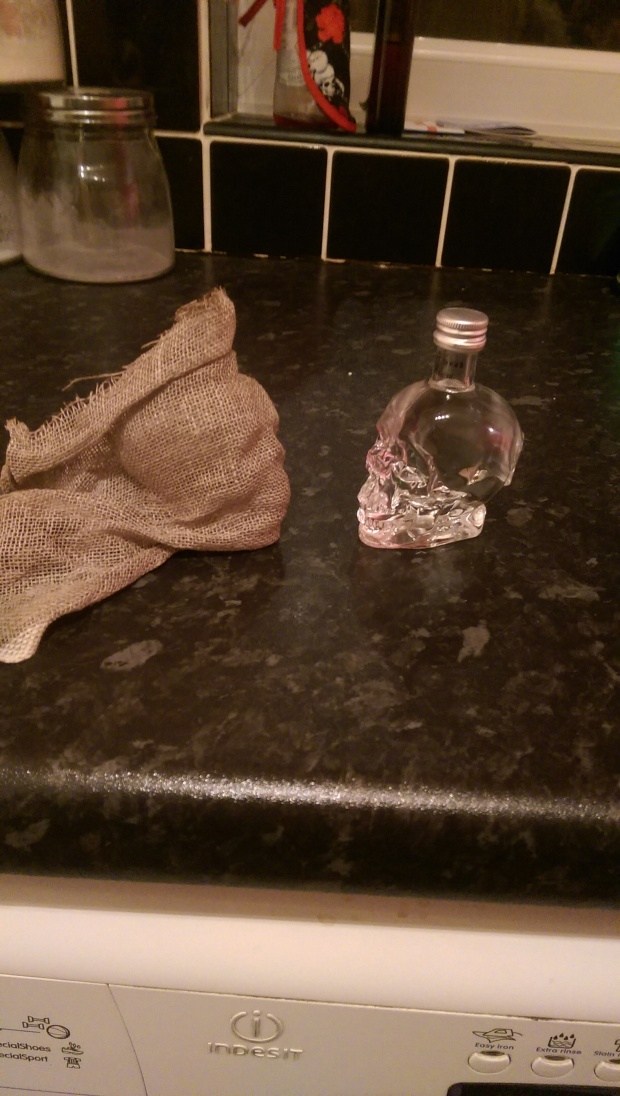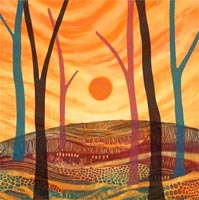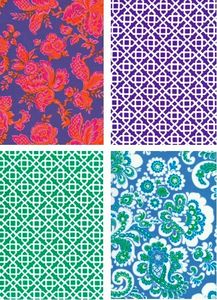I’m really struggling with ideas for my theme book at the moment. I have ran through so many ideas that I would like to do: land and seas capes, gothic, japan, moths, traditional tattoos, and I still just have no idea what I want to base my theme book on which is rather worrying. One of my biggest influences is nature and my surroundings but I’m not sure if I want to venture into unexplored territory for it. I have many passions in life and I can’t seem to settle on a theme that feels right for me.
Category: Part 3 – Creating Shapes and Three-Dimensional Forms
Tutor Report – Assignment 3
Overall Comments
Laura, you have explored various methods of manipulating, layering and bonding materials building a valuable set of new skills that you can take forward. Your online learning log continues to develop, charting effectively your development through this course. This includes personal reflection and evaluation of research directions, sketchbook work, photographic images of textile sampling plus the visit to the York Quilting Guild. The A3 pages submitted evidence the techniques tested. There are some interesting ideas and concepts plus evidence of skillfully crafted sampling. I do feel there was greater scope for more testing, extending experimentation and more in depth research. You have successfully begun to touch on research directions; I would suggest that you now investigate further by citing, cutting edge designers, artists and makers within these fields.
I understand your aim is to go for the Textiles Degree and that you plan to submit your work for assessment at the end of this course. From the work you have shown in this assignment, providing you commit yourself to the course, I believe you have the potential to succeed at assessment. In order to meet all the assessment criteria, there are certain areas you will need to focus on, which I will outline in my feedback.
Research Point
Laura, after the introduction, the course materials ask you to investigate the diversity of style and design in textiles available to the consumer. This may include: fashion, furnishing, textile technology, high performance fibres or traditionally based designs and techniques. Within your learning log you were asked to make notes regarding which textile techniques are fashionable currently plus which items that you have collected appeal most and why?
In relation to this task, I can identify some pages of the sketchbook submitted. Here, you have constructed two small (A5) mood boards with: selected images of fabric samples from a free magazine and pictures from the wedding section plus a diagram and some hand written notes with reference to: Robert Kaufman, Art Gallery Fabrics, Birch Fabrics and Sarah Jane Studios. Your online learning log supports sketchbook mind-‐maps. Here, you have expanded on areas of interest including: quilting by Ellyn’s Place, laminated fabrics by Jennifer Paganelli, contemporary woven design by Holly Berry and touched on digital printed catwalk trends.
Laura, you need to expand on this by including cutting edge designers renowned for their contemporary practice; plus discovering in more depth, the technologies involved. These are some examples:
Stella McCartney who designed Team GB’s kit for the 2012 Olympics and will be designing for Rio 2016.
http://www.stellamccartney.com/gb/adidas_section
http://fashionista.com/2015/07/stella-‐mccartney-‐adidas-‐rio-‐2016
Helen Storey: A fashion designer who has moved into working with scientists in developing new technologies that sustain the environment: http://helenstoreyfoundation.tumblr.com/
http://www.helenstoreyfoundation.org/
If you are interested in interior design look at the leading designers within these fields plus researching the possible links to historic design including perhaps the Baroque and Scandinavian design that support current trends.
Have a look into inspiring designers such as Carola & Daniel Olsen and Lucienne Day from Heals (mid 20th Century).
http://robinandluciennedayfoundation.org/
Heals Archive – Design:
http://www.heals.com/heritage/
For the historic referencing of Baroque design the V&A:
http://www.vam.ac.uk/content/articles/s/style-‐guide-‐baroque/
Feedback on assignment
Demonstration of technical and Visual Skills, Quality of Outcome, Demonstration of Creativity
A3 Development Pages: Project 6 – manipulating Fabrics.
Stage 1. Preparation:
Laura, via your online learning log you have evidenced putting together a collection of soft furnishing fabrics including sofa, carpet and bed linens. One photographic image is visible therefore I don’t believe you entirely resolved this exercise. The example in the course material incorporates images, yarns, artists’ reference as well as fabric swatches.
Stage 2.
Developing Ideas: On reading your online learning log I understand that you chose not to use any of your previous drawings and designs. This was because you were not happy with this foundational work. Instead, you selected new inspirational material to work from. However, the course materials suggest choosing six interesting drawings or other source material. Here, the purpose is to find uncomplicated shapes, patterns, and textures finding expressive qualities and rhythm.
It appears that the only sources of inspiration, evidenced for this body of work is the card found in a local art shop depicting a printed landscape by Rebecca Vincent plus references to the Quilting Guild research visit. You were asked to make five or six small collages of fabric, combining textures, playing with removing threads, trying different proportions. I can see no evidence of this. Even with the limited inspirational research material, I do believe you could have expanded experimentation and testing of materials.
Stage 3: Applied Fabric Techniques.
Laura, the embroidery hoop samples do reflect effectively the mood and theme of the inspirational image. Here, you have shown very competent technical and visual skills, plus competent realisation of ideas, presented well, showing judgement. The larger hoop evidences skilled applique, layering of materials, considered colour palette, and hand embroidery techniques. This captures well the essence of the artist’s card. However, the reasoning for selecting from your own sketches and design work is to find original and unique design ideas. This is an accomplished piece but I do feel that you could have created more design and artwork to support this.
The smaller hoop is particularly successful. Whilst at the Quilting Guild you encountered a piece that was composed with small squares, layered and cutaway. This evidences an effective grasp of ideas and communication of those ideas visually. Well done, this is a lovely piece especially in the use of materials. I enjoyed the way in which text is over-‐laid with muslin plus the cutting away adds dimension and depth. This is an original, interesting design piece although again you have very little evidence of design drawing and testing colour or composition. In fact, the simplicity of this colour palette works very well in the way in which bold red is used sparingly against cream and white. Well done.
The applique floral design is derived from looking at traditional tattoo style drawings. I can see evidence of these colourful drawings within your sketchbook although there doesn’t appear to be any evidence of traditional tattoo designs (images, websites, etc.). You note that you did struggle with the Bondaweb, however, again this is a competent sample. The blanket stitch was used to hide unsuccessful edges and it actually works very effectively, with reference to tattoos. This is a bold and striking piece in composition and design.
Stage 4.
Raised and Structured Surface Textures.
Laura, you have evidenced: gathering, folding, pleating, tearing, fraying, quilting, molding and raised shapes. I particularly like the tearing, fraying and slashed samples as these have more of a contemporary feel in depth, texture and proportion. There is some creativity exhibited here with a few imaginative outcomes. I strongly believe you need to develop these methods further, via more extensive experimentation. I would like to see you develop these further by testing ideas with a series of each method. Consider producing at least three samples per method (I suggested this in your last assignment feedback).
Try reflecting back to mark making exercises and finding methods of creating organic, abstractions via quilting, collage (applique) and manipulation techniques. Think about the possibility of taking elements from either: life drawing, still life, landscape, organics and capturing the essence. This may be the texture, colour palette, shape, and line of the form chosen.
Look at designers such as Issey Miyake:
http://www.google.co.uk/search?q=issey+miyake+pleating+technique&hl=en-GB&gbv=2&sa=X&oi=image_result_group&ved=0CCYQsARqFQoTCN7N6aDKiscCF YVq2wodxx8Cvg&tbm=isch
Pleating:
http://thecuttingclass.com/post/4388965503/mccanrtney-‐miyake-‐fortuny
Embossing:
http://thecuttingclass.com/tagged/fabrics-‐and-‐textiles
Contemporary Quilting:
http://www.contemporaryquilt.org.uk/fine-‐art-‐quilt-‐masters.html
Final Piece.
The course materials ask for you to make a final piece inspired by your drawings. Develop the drawing by possibly masking off an area and enlarging it, photocopying and cutting it up to reassemble. Calico is suggested as a base cloth. I cannot find evidence of this within your online learning log or the work submitted.
Laura, I would suggest that in future try not to discard previous art and design works. Often all artists are dissatisfied with their pieces however often we can look back and re-‐visit a work finding aspects that can inspire future projects. This may be a small area of detail, a brush mark or a roughly drafted sketch. Perhaps even re-drawing or manipulating an image can rejuvenate an idea. All work is valuable and can be used to move forward.
Sketchbooks
Demonstration of technical and Visual Skills, Demonstration of Creativity
Laura, within your online learning log you state that you are ‘super happy’ with your sketchbook work for this assignment. I would agree that it is developing with collage, fabrics, themes, notes, research points, colour palettes, sketching and design ideas.
The sketchbook submitted has evidence of sketching and development work for this assignment. This includes studies of floral motifs; quilt design, experimenting with shape and pattern. The sketching here is of a good standard and you evidence a clear ability to express ideas via drawing, however, I do think this needs extending and developing further.
Consider being braver with materials try sketching on alternative papers such as recycling paper bags, old packaging or discarded giftwrap. I suggest you have less control regarding the outcome allowing the materials to guide you. Enjoy the process of being playful and expressive with media. Try layering materials as you have with cloth. Look at tissue papers, baking parchment, transparent and semi-transparent against opaque card, brown paper, corrugated, recycled. Perhaps engage in finding textures to explore, mixing opposites and drawing into these with charcoal or graphite.
It is good to see you using mind mapping within your sketchbook via the diagram exploring diversity of style and design in textiles. Plus you have begun to build effective mood boards including relevant text. Your visit to the Quilting Guild is documented here, with further research into quilt design. Well done.
Theme Book:
Now is the time to really get to grips with your theme book. Your idea is based around moths. I am interested in this theme, as it opens up many exciting possibilities. Often moths are linked to decay, worn musty clothing, eaten away holes in natural fibres, and dusty archives. I look forward to seeing some ideas in your next assignment submission.
Learning Logs or Blogs/Critical essays
Context
Research Points:
Laura, I have already stated that you need to resolve your notes regarding ‘style and design in textiles’. On the final page of assignment 3, the materials ask you to look at the diversity of textiles that are craft based in their production and why craft based textiles retain a place in our society.
It is now time to research further into the agencies that support both craft and design. Here, you will find a more academic view plus grounding for your ideas:
http://www.craftscouncil.org.uk/
Plus: Look at sites such as: The Design Council.
Laura, it good to see that your online learning log is developing documenting your journey. You use photographs to illustrate your textile and artwork plus reflective commentary. Be careful with language such as using: “But, yeah. I’m very happy with the work”. Consider un-‐packing ‘why’ you are ‘happy’ with an outcome. Think about texture, colour, technique, applications and reference to research plus inspiration. Analyse the factors that made the piece successful in your eyes.
You have documented your research visit to the Quilting Guild. Again, expand on this exciting experience (your passion). Here, you stated that, a work made by prisoners resonated with you, why? What was it that captured your attention? Try evaluating the works you experience, the composition and how you felt.
You have made a good start to building a bibliography, extend this including: websites visited, books, articles, magazines, films, documentaries, exhibitions and inspirational sites, etc. You express your own views very well but need to reinforce this with evidence that you have considered other forms of relevant research such as designers, artists, associations and academic opinion. There is evidence of self-reflection and research and satisfactory ability to analyse and synthesise information.
Consider looking at the following:
http://www.textileartist.org/cloth-creativity-collaborating/
Consider looking at more contemporary makers. Jan Beany for example and the way in which she builds layers, texture, colour and abstracts elements of the representational. Capturing the essence.
http://www.textileartist.org/jan-‐beaney-‐and-‐jean-‐littlejohn-‐interview/
Tracie Peisley, her use of collage type garment construction. A very different artist in comparison to Jan Beany, as Tracie Peisley uses bold, vibrant compositions! Her philosophy is very interesting:
http://publicservicetransformation.org/social-‐justice-‐home/75-‐talk-‐back-‐2/603-‐in-pursuit-‐of-‐the-‐original
Suggested reading/viewing
Context
For Surface & Manipulation:
Japanese Textile Artists
Machiko Agano
http://transitionandinfluence.com/gallery/machikoagano.html
Koji Takaki
http://www.directdesign.co.uk/testDD/transition_gallery/kojitakaki.html
Shihoko Fukumoto
http://www.artcourtgallery.com/eng/artists/fukumoto/
Kyoko Kumai
http://www.browngrotta.com/pages/kumai.php
Masakazu & Naomi Kobayashi
http://www.browngrotta.com/pages/kobayashi.m.php
Asako Ishizaki
https://textileartscenter.wordpress.com/tag/asako-‐ishizaki/
Scottish Textile Artist:
Norma Starszakowna
http://www.vam.ac.uk/content/articles/d/diasporas-‐hanging-‐textiles/
Books: • Monk Lynda (2012) Exploring Creative Surfaces, ISBN: 957441309, D4Daisy Books.
Pointers for the next assignment
• Maintain your good working practice via extending exercises, perhaps review work and make series of samples (perhaps 3 – 5 samples) per story or application method (as suggested in previous assignment).
• Revisit the research points in this assignment.
• Reflect on previous work and find aspects you like and could develop.
• Try not to discard foundational works. Consider, building on it or adapting it to suit the new brief.
• Continue to develop your sketchbook work with exploring mixed media as well as, sketching, drawing and painting.
• Try being free, less constrained and playful with materials, applications and media.
• Continue to look at contemporary artists, sites, and exhibitions for inspiration & research purposes. Expand by making lists of artists – as to why you identify with their work.
• I know costs can be limiting but look at the materials you have at hand and test, develop and push the boundaries by using techniques such as distressing, printing, burning, fraying, etc.
• Use old clothes, bed linen, and charity shops for materials.
• Develop your Bibliography including website links, textbooks, articles, magazines, film and relevant research sites.
Laura, well done, in submitting a creative body of experimental design work, I look forward to your next assignment.
Project 6 – Stage 4 Extra
The last technique I was told to try out was moulding. I didn’t include this with the previous post in this section as I was waiting for some hessian to be delivered to try it out. I was a little sceptical to begin with about this as I didn’t have any PVA glue to try it so was really hoping the hessian would work as stated in the brief but I must admit I’m pretty excited with the outcome. I used a small bottle of Crystal Head vodka I got when on my honeymoon in Bruges and it looks really cool! And given that I’m thinking of a 3D project for my theme book and final design, this could be very interesting to start with!
Pretty cool/creepy huh?
Assignment 3 – Critical Assessment
Level 4 critical assessment – Looking for laying the foundations – acquisition of skills and good working habits (keeping sketch books and learning logs) – 4 areas of focus: Demonstration of technical and visual skills, quality of outcome, demonstration of creativity and context.
Demonstration of technical and visual skills – I think I have been fairly competent in this area again. I feel I have showed a bit of versatility in my samples ranging from landscape, sketch type designs to bold and alternative style work. I am happy with the visual outcome of my work for this assignment.
Quality of outcome – I am pleased with the quality of work I have produced. I feel the quantity is a little lacking but I am still happy with my finished samples. I aim for the next assignment to really get more involved and rework some sample to see what I can do to improve and develop them.
Demonstration of creativity – I think I have showed a lot of creativity in this assignment. I feel I have tried out a few different styles of design that have allowed me to see what I am capable of and find what I enjoy to do.
Context – I am happy in this area. I am looking at other artists working (following some on social networking sites and such) and visiting museums and exhibitions when and where I can. I still need to be a bit more hands on in this area but honestly, all comes down to money. I don’t drive so I find it costly to get out of town often but I am happy in the fact that I do what I can when I can.
Feedback – Level 4 – I am pretty pleased with my work for this assignment. I feel I have developed well since my last one and that I am finally getting a voice of my own. I know what I enjoy and I have been very happy with developing my ideas and trying out new techniques.
Project 7 – Your Theme Book
I have played with a few ideas so far for my theme book: Japanese, tattoos, gothic but I think I have finally landed on something that I want to look at. Moths. Moths have some amazing markings and are so beautiful and I really enjoy looking at them and sketching them so I’m thinking moths. This may change, I’m very undecided on what to do as there are so many things I would like to try out but at this point in time, I’m thinking moths.
Project 6 – Stage 4 – Raised and Structured Surface Textures
This was alot of fun. I really enjoyed experimenting with the different types of techniques and there are a few I’m looking forward to using again like the slashing, freying and tearing.
I was then asked to reflect and answer some questions:
How does working with fabric in this way compare with working directly with stitch?
I really enjoyed manipulating fabric. I feel you don’t have as much control over the end result as you do with stitch but that’s half of the fun. There may be something you’re trying to achieve but end up creating something even better.
Are you pleased with the shapes and movements that you have created in both applique and fabric manipulation? What would you do differently?
I am very happy with my results. I feel like I managed to ca[pture what I was wanting to with my appliqued pieces and enjoyed seeing the different ways fabric reacts to manipulation. I think the only thing I would do differently is try the same techniques with different fabrics to see the different reactions between different fabrics.
How did the pieces work in relation to your drawings? Were the final results very different from the drawings? Did the fabric manipultion technique take over and dictate the final result?
I think the pieces worked well with the ideas I had in mind. I didn’t have a specific picture for the manipulation which I why I just kept to sampling each technique but I feel I had a slight idea of what I was wanting to achieve with each sample and feel they came out how I had been wanting. The manipulation does take over though and I found my fabric reacting in ways I hadn’t anticipated but this was thrilling to see and I really look forward to developing with these techniqies.
Was it helpful to work from the drawings in the applique exercise? Would you have preffered to play directly with cut shpaes and materials?
It was very helpful to work from drawings to begin with. Especially as I had never done applique before, it helped give me a starting point. I enjoyed working with the cut shapes in my final sample too and feel I would much rather enjoy working with cut shapes.
How do you feel about woking with stitch in general? I it an area you would like to pursue in more depth? Do you find it limiting in any way?
I love working with stitch. I love seeing how a simple piece of fabric can be brough to life with stitch. I would like to persue applique a bit further and the tearing, freying and shreading manipulation too. The only thing I find limiting is working by hand. It’s very time consuming and sometimes when my stitches aren’t tight enough or I’m trying to sew through several layers of fabric, it can be quite difficult but if I had a sewing machine then I think these issues wouldn’t be there and I would be able to work a little more freely and experimentally. I’m looking to invest in one very soon.
Project 6 – Stage 3 – Applied fabric techniques
I started with the hill image that I had in mind and used a herringbone stitch to layer the fabrics. I tried a few ideas with this, I was wanting to do trees over the top to try and develop an image I made in a previous assignment of trees silouetted against a background but when I tried it, it just didn’t look right so I decided to go for an organsa sky. I used sttitch to develop texture into the piece too and gold thread (which I found very difficult to work with as it doesn’t easily comply) to add the sence of sunset upon the field.
I really like this finished piece. I decided to leave it in the hoop as I think, presetation wise, it looks pretty effective.
The breif then talked about cutting away applique and I decided to try something I had wanted to try since I saw something similar at the York Quilting Guild Exhibition. I also decided to try out trapping things inbetween layers so I added some ripped up pages from an old book and laying it between my base fabric and a layer of organser and used a randon marking stitch to hold in place. I’m not sure if this is exactly what the breif was asking me to do but this was my interperatation and I enjoyed doing something a little different. Again I left the finished sample in the hoop for presentation.
Lastly I decided to try something completely different after spending a little time playing with traditional tattoo style drawings. I tried applying fabric with bondaweb but it went awfully wrong and I ended up getting it everywhere so I had to redo it with a blanket stitch to hold it down. My blanket stitch needs work as it was a little loose but I do like the overall effect. It looks like a little Frankenstine Rose really.
Project 6 – Stage 2 – Developing Ideas
I decided to take inspiration from a card that I’d found in my local art shop for my first sample.
I was attracted to the colours and the marks in the different levels of the hills. I went through more of my fabric and decided on the ones I was going to use.
There was a mixture of printed japanese fabric, organsa, felt and cotton.
Project 6 – Stage 1 – Preparation
Stage 1 asked me to look at my fabric samples and decide on which ones I was going to use to create my first appliqued sample. Because I had quite a long break between my last assignment and starting this one and not being happy with my previous assignment work I decided to start from scratch and so didn’t use old drawings to develop but with a new outlook, worked from inspiration I had collected since starting back up.
These are the samples I started with. These are a collection of soft furnishing fabrics that I had ordered samples of from my Research Point. There are mixtures of sofa, carpet and bed linen fabrics.
Research – Diversity of Style and Design in Textiles
So its been months since I’ve even picked up anything to do with this degree which is personally saddening and disappointing but never the less I feel I am ready to start getting stuck in again and that starts with Part 3 of the course ‘Creating Shapes and Three-Dimentional Forms’. The research point for starting this is to investigate the diversity of style and design in textiles available to the consumer. Considering I’m had such a long time away from anything textiles related I found this a very complex and overwhelming questions really. It’s such a vague starting point that the amount of things that could be researched to fullfil this question is HUGE! There are so many different types of fabrics and techniques available I could spend possibly the next month researching this! So I decided to start with a mind map to kind of get a flow for what I was going to be looking at.
This helped me pick just a handful of things to potentially look at. So I started with quilts and throws.
There are lots of different fabrics that are being used currently in quilting, brightcolours, neutral tones and organically made fabrics being the rulers. These types of fabrics are being used to create contemporary designed pieces but using old school techniques to embellish them such as hand embroisery and traditional quilting patterns. For example this piece called ‘Mini Swoon created by the owner of a blog called ‘Ellyn’s Place’
She has used traditional patchwork technique to assemble this piece which, with its use of irregular shapes band unusual structure, has a very contemporary feel about it. She has also embellished this further with so straight line stitches over the top to give the quilt texture and depth. It’s a very simple yet effective example of traditional techniques meeting modern design.
Laminated fabrics are also helping to modernise the very old craft of quilting. Unlike the thick and garish laminated cloths that my grandma uses on her dining table, which I was forced to remember when laminated fabrics where first mentioned, these ones are soft, flexible and easy to work with and are becoming a popular choice for things like handbags and cosmetic cases due to their wipe off abilities. They are also keeping up to trends with their bright and bold colours and prints.
These prints are only a small selection of what designer Jennifer Paganelli has available showing that these laminated fabrics can be just as pretty as any standard printed fabric.
Another great example of how traditional techniques and contemporary design are now becoming harmonious partners in current trends is by designer Holly Berry. She creates modern designed throws using a traditional weaving technique.
Her use of colour mixed with trending Nordic, geometric and tartan patterns creates amazing throws that remind you of ‘the good old days’ and will give a cozy feel to any home.
Digitally printed fabrics are also being used a lot in both furnishings and fashion. Digitally printing onto fabric is a time friendly, budget friendly and eco friendly (we can now obtain earth friendly inks and recycled materials as well as decreasing the amount of water involved in dying items when making by hand) way of mass producing printed products and with today’s technology digital printing offers photorealistic images and vibrance which means you can make a print to look like an original hand painting. This pillow and these trending fabric patterns for example,
It looks like someone has painted the fabric by hand when in fact it is digital print. And this technique often makes headlines on catwalks which allows complicated and fussy geometric patterns to become a statement feature in the Autumn/Winter 15 collection.
I’m sure there is so much more to find out about the different styles and designs available to consumers as I feel I have only jsut scratched the surface with the research I’ve done so far and I’m looking forward to looking a little more in depth in the coming months while I finish this course.
I have thoroughly enjoyed this research point. Where I found this a daunting task at first, I now feel this was the perfect start to getting back into this course after my absence. I feel I have connected a little to current textiles and fashion trends which I have definitely been out of the loop with. I particularly like the woven blankets by Holly Berry. I would really like to try out this technique or at least research it further as I’m interested in how she creates her different and geometric designs using a loom. I’m really looking forward to looking at these trends a little more before moving on to the next stage to inspire myself and hopefully end up with a sketch or two in my sketchbook.
